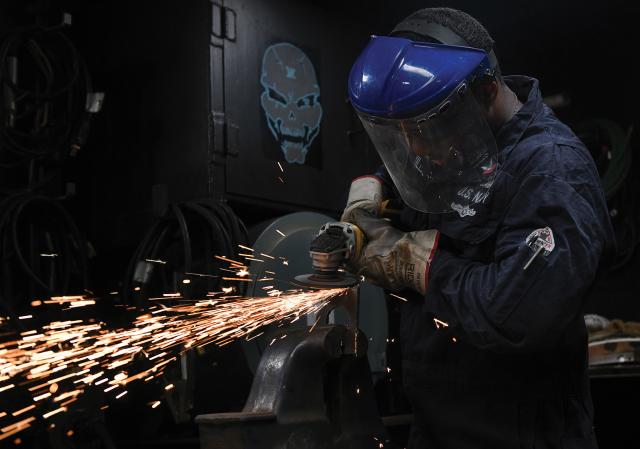The threats facing the Navy are growing at an exponential rate. To answer these threats, many of which are asymmetrical, the service has fostered an environment that promotes toughness and resiliency. One area that has been examined, but not thoroughly enough, is the self-sufficiency of ships at sea and their ability to remain on station in the high-end fight. The organic repair capability the Navy once possessed was second to none and world renowned, but this is no longer the case.
The Navy started to lose these key repair skills with the decommissioning of the Shore Intermediate Maintenance Activities (SIMAs) in the early 2000s. These maintenance centers were at all major fleet concentration areas and served a few critical purposes the Navy lost when their doors closed. They were first and foremost learning centers, where journeyman-level skills were honed and then used to repair ships faster and more efficiently than is possible today. More important, they were an investment in the future of the Navy. Junior sailors reporting to a SIMA after their first sea tours brought the skills they learned back to their ships when they went back to sea, and Navy ships gained experienced and knowledgeable technicians who were mission-oriented and very rarely said, “I can’t fix that.”
Another mistake was reducing the number of brick-and-mortar schools that once were a mainstay of the Navy education system. These schoolhouses used many of the same senior sailors stationed at SIMAs in past tours to teach junior sailors troubleshooting techniques and how to analyze equipment and systems, so repairs could be completed at the lowest level. The current computer-based training regimen may seem effective on paper, but on a deckplate level, sailors are clicking through a three-week course and are then sent to a ship as “journeymen.” Cost does, of course, have a vote in this. Virtual training saves the Navy money; however, the firms making money from computer-based training also are not likely keen on seeing it go away.
The regional maintenance centers of today are cumbersome and overworked, from the craftsman level up to management. The original idea was to get rid of SIMAs and hire civilians, many of them retired sailors, and then apply the Lean Six Sigma approach to fixing ships. This is applied at many levels in the Navy today—how to do more with less. There is no simple answer; however, it has become clear that getting civilians to do their job versus getting sailors to do their jobs is like night and day. Those civilians employed by regional maintenance centers will remain in the same jobs for 20 years, working under business rules that make it almost impossible to discipline them for below-average performance, all while they make double the salary of a sailor who was in the same billet 15 years ago.
The failures of the maintenance community are based in the casualty reporting system (CasRep). The maintenance community has made it mandatory to CasRep any and all issues that need to be fixed by off-ship entities. This has diluted the fundamentals of a CasRep system that has been around for almost half a century and made it seem as though commands are “crying wolf” while trying to justify the reason for the maintenance community: to fix ships. Much of this blame can be placed on ships as well. For example, the lack of troubleshooting skills is rampant in the fleet and leads to ships ordering an entire engine when all the engine needs is a new piston. This puts an unbelievable strain on a logistics system geared toward supply-and-demand trends and metrics, and leads to spending money at an alarming rate and decreasing the effectiveness of the maintenance program.
There is a light at the end of the tunnel, and fortunately some commanding officers are taking matters into their own hands—asking the hard questions when a piece of gear goes down and getting involved in the disassembly, diagnostics, and repairs. If you practice this simple philosophy, your sailors will take more pride in their equipment and the overall warfighting efficiency of your command will increase exponentially. Teaching division officers this basic skill pays dividends later on in their careers as well. Regardless of what they have a degree in, division officers should be immersed in what their division is doing and keeping their team on the path forward, resulting in all equipment they own being operational.
As retired Fleet Master Chief Paul Kingsbury recently said, the Navy must stop placing more administrative burden on chiefs and let them be the deckplate subject matter experts that they have been since 1898. These chiefs are responsible for training the commanding officers of tomorrow and the sailors who show up to ships with only computer-based training. We entrust them with huge responsibilities, and then we pile collateral duties on them, diminishing their base effectiveness and taking them away from their historical stomping grounds.
Deckplate leaders should use the 3M system (materials, maintenance, and management) to its full advantage by ordering the right parts at the right time and empowering supply officers to manage the funds they are given to get the mission done. The preventive maintenance system, if used correctly, can help find problems before they become problems, allowing sailors to fix systems long before they become inoperable. The reliability-centered maintenance principle has within it the means to develop trends to help determine when a particular part in a piece of equipment will fail—it just needs to be. When we troubleshoot down to the smallest component in a system, we increase sailors’ knowledge base and spend money on parts ships actually need, and that is the definition of self-sufficiency.
The Navy needs to curtail the plethora of inspections ships have to go through so sailors have the time to actually fix and maintain their systems. The average cruiser or destroyer engineering department will go through more than 20 individual inspections in a year. Add to this a deployment and workups in the same year, all while depending on a maintenance community that has numerous other ships to maintain and repair, and you can easily see how the number of inspections can be counterproductive to maintaining material readiness. Most of the inspections and training team visits could be streamlined to get at the real issues.
Last but not least, bring back brick-and-mortar schools, and create more billets in shipyards and regional maintenance centers for sailors. That investment is the key to longevity. Teaching journeyman-level skills to 22-year-old sailors, versus hiring a 50-year-old retiree, is smart math and will save the Navy money in the long run. The service must be willing to make that investment and get back to brilliant basics. The capability to fix our ships at sea cost-effectively is a basic requirement of the Navy. The resources are available—we just need to realize what is in front of us and capitalize on it. We will be a better Navy for it.







